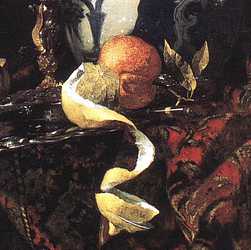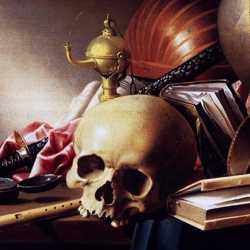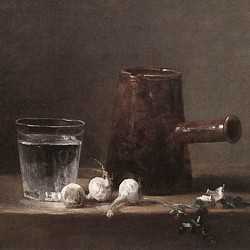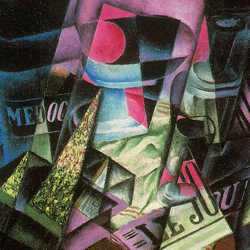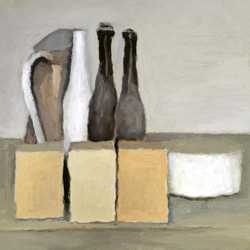Still Life Paintings by Chardin
Chardin was one of greatest still life painters in the history of art. The intensity of his vision opens our eyes to see beauty in the everyday objects that surround us.
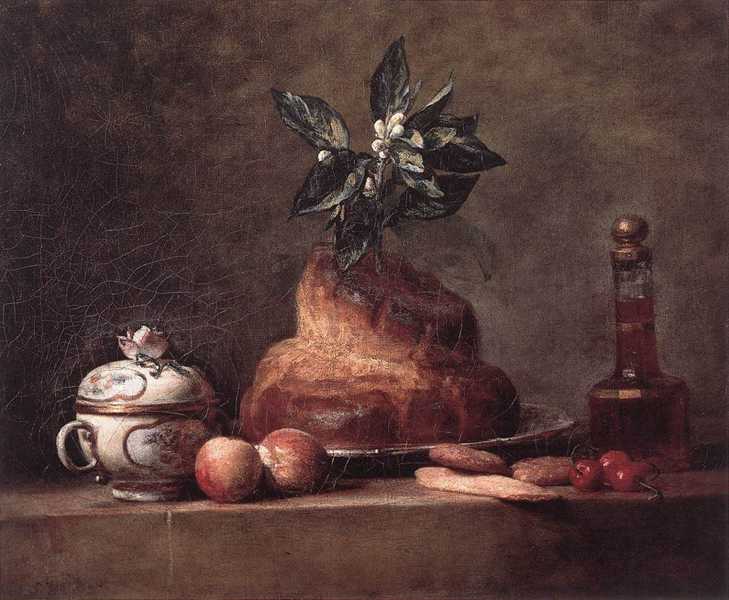
JEAN BAPTISTE SIMÉON CHARDIN (1699-1779)
'The Brioche', 1763
(oil on canvas)
Jean Baptiste Siméon Chardin was one of greatest masters of Still Life in the history of art. The painting style of the establishment in his day was Rococo: a pretentious style, crammed with allegorical images from classical mythology and swirling with ornate decoration. To Chardin this theatrical approach reduced art to some kind of intellectual conversation piece. It was totally alien to the world that he constructed - a simple world of truth, humility and calm played out in a few square inches on the canvas.
The items he portrayed from his own home were selected for their shapes, textures and colours, rather than for any symbolic meaning they may have had. They were simply painted to convey the visual pleasure he experienced in looking at them. As his friend, the critic Diderot put it, “To look at pictures by other artists it seems that I need to borrow a different pair of eyes. To look at those of Chardin, I only have to keep the eyes that nature gave me and make good use of them.”
What Chardin strove for was an overall effect: a unity of tone, colour and form. His still lifes reveal themselves slowly, with his objects gradually emerging from their subtly toned background, summoned as the writer Marcel Proust puts it, “out of the everlasting darkness in which they have been interred.”
Chardin's Painting Technique
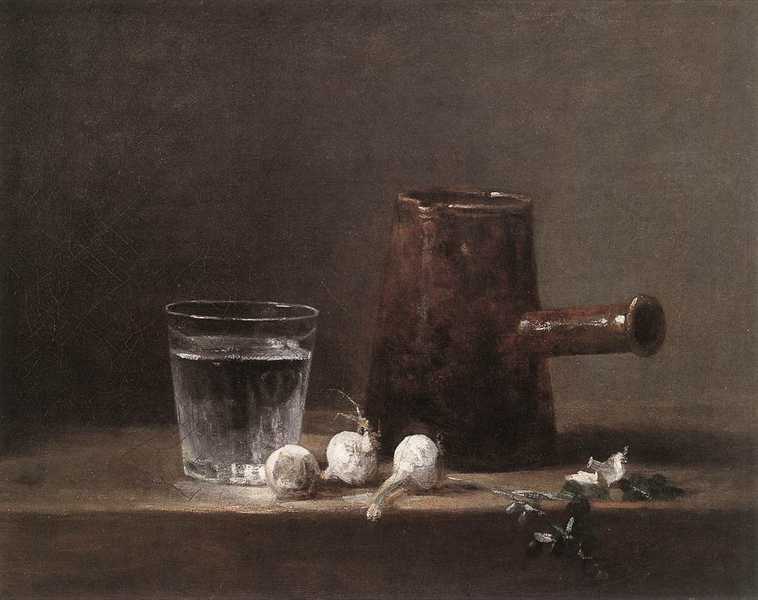
JEAN BAPTISTE SIMÉON CHARDIN (1699-1779)
'Glass of Water and Coffee Pot', 1760
(oil on canvas)
Chardin would prime his canvases with a brownish pigment, sometimes tinted with red or green. This would give him a neutral background to paint on. On this he would brush in the darkest tones, then the mid-tones, and finally the highlights. When he arrived at the correct tonal balance, he would add colour, being careful to maintain the overall harmony. He would finally complete the work by going over it again with the colours he had already used in order to create the reflections and highlights that tune and unify the composition. In 'Glass of Water and Coffee Pot', the same white that is used for the cloves of garlic is echoed in the reflections from the glass on one side, and in the burnished highlights of the copper coffee pot on the other. The range of browns across the picture are united by a subtle hint of the same green used for the garlic leaves.
Chardin always looks at the world as if he is seeing it for the first time. The intensity of his vision focuses on the beauty of the everyday objects that surround us - a beauty that we take for granted as we are often too close to see it. From Chardin we learn that there is hidden character on the charred surface of an old coffee pot, or a jewel-like radiance in the crystal clarity of a glass of water. Like all good art his paintings open our eyes and teach us to see afresh.
Chardin's Composition Techniques
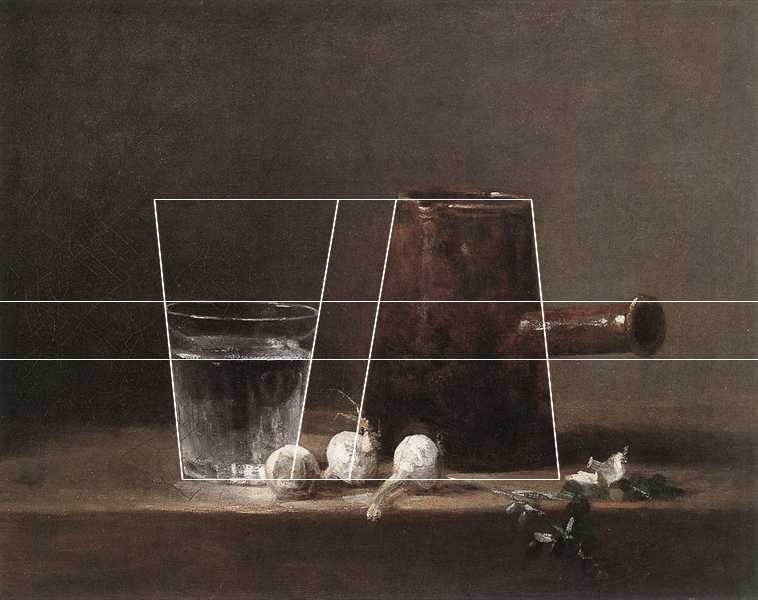
The hidden geometry in 'Glass of Water and Coffee Pot'
Chardin's 'Glass of Water and Coffee Pot' contains many of the key elements of his deceptively simple still lifes. His subject matter is always secondary to his search for the compositional balance of tone and colour. The subject comprises three common kitchen items arranged on a concrete shelf: a glass of water, a charred copper coffee pot and a few cloves of garlic. It is the harmonies and contrasts that he builds into the visual elements of these ordinary objects that make this painting extraordinary.
The glass and coffee pot are both truncated cones, but the shape of one is an inversion of the other. The balance of these two opposite forms creates a dialogue between their shapes. This balance of opposites continues through other elements: the glass is light, transparent, cold, smooth and reflective, while the coffee pot is dark, opaque, warm, rough and charred with soot. Even the details of these objects are carefully balanced as the handle of the coffee pot and the glass from the water level up both occupy the same horizontal strip on the picture plane.
Chardin balances the tonal values of the glass and the coffee pot by creating a counterchange with the background. He carefully graduates the tone of the background from dark on the right to light on the left. This results in a contrast with both objects: the glass looks brighter against its dark background while the coffee pot looks darker as its background becomes lighter.
There is a basic rule of composition that states you should not have a long unbroken line parallel to the bottom of the picture, as this creates an area of 'dead space'. Chardin introduces the garlic and its foliage to break the long line of the shelf and to enhance the illusion of space at the front of the picture. They also act as a compositional device to lead the viewer's eye into the painting and to link all the objects together. As softer organic forms, they create a welcome contrast to the hard geometric shapes of the glass and coffee pot.
Chardin's Variations on a Theme
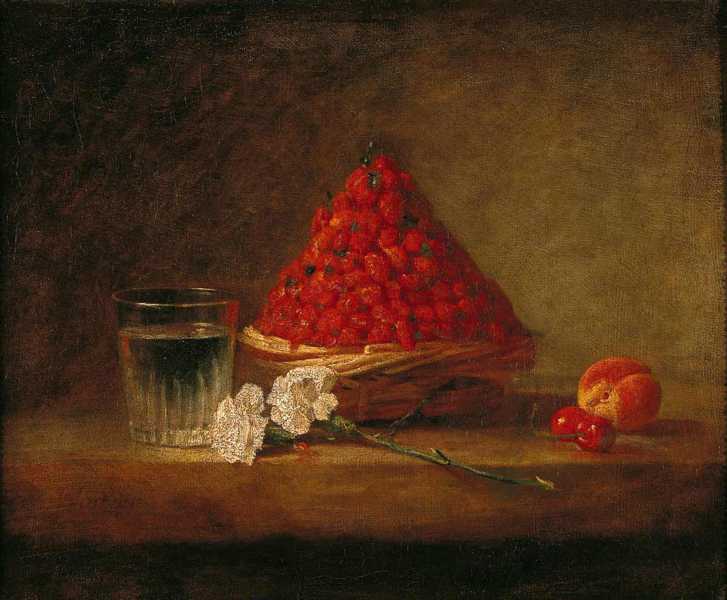
JEAN BAPTISTE SIMÉON CHARDIN (1699-1779)
'A Basket of Strawberries', 1761
(oil on canvas)
Many of Chardin's favourite still life objects reappear in other compositions. In 'Basket of Wild Strawberries' he uses the same glass in a similar arrangement to 'Glass of Water and Coffee Pot'. His purpose in doing this is to discover variations of the harmonies and contrasts that he explored in the earlier painting. Here he uses a tonal counterchange that transitions horizontally across the axis of the strawberry 'cone': the light edge of the strawberries contrasts with the background as it darkens, while its dark side becomes more visible as it lightens. Again he develops the relationship between the objects with his use of color: he links the red of the strawberries to the glass of water through its reflections and then counterbalances this movement with the red cherries on the right. The soft pink of the peach is similarly harmonized by the warm tints on the front face of the ledge. Finally, to give his color an added kick, the intense hue of the strawberries is complemented by the green of their receptacles, while the green stems of the carnations are enriched by the addition of a red bud.
Chardin's Appeal to Modern Artists
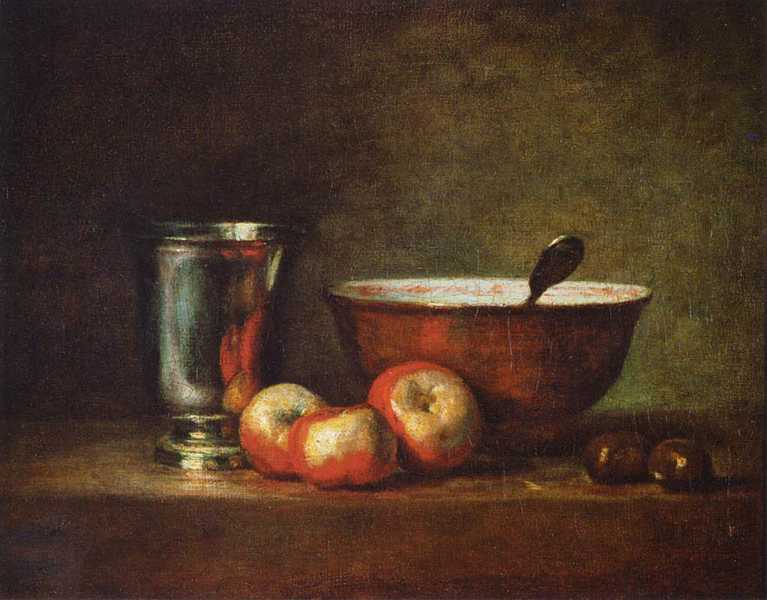
JEAN BAPTISTE SIMÉON CHARDIN (1699-1779)
'The Silver Cup', 1769
(oil on canvas)
Chardin’s paintings appealled greatly to modern artists such as Cézanne or the Cubists, who are accustomed manipulating the abstract elements of a painting to achieve a mutual harmony between form and content, subject and technique. They share the same ideals: a unified composition reached through the analytical drawing of pure forms, uncluttered by emotion and without any superfluous detail.
Chardin Notes
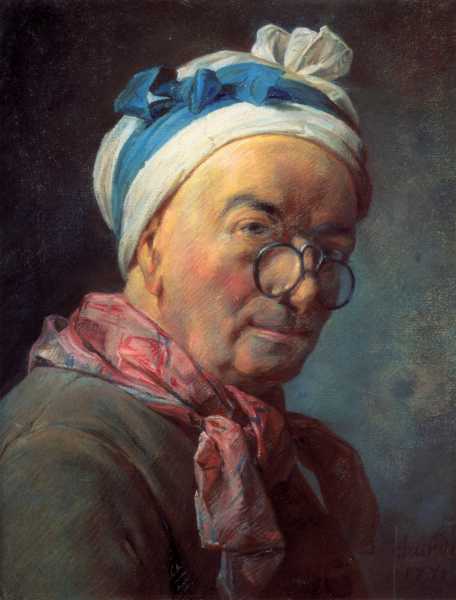
JEAN BAPTISTE SIMÉON CHARDIN (1699-1779)
'Self Portrait', 1771 (pastels)
Chardin was one of the greatest still life painters in the history of art.
-
He found beauty in the everyday domestic objects and utensils that surrounded him.
-
He often painted the same objects in different still lifes.
-
He chose the objects in his still lifes for their shapes, textures and colours, rather than for any symbolic meaning they may have had.
-
He carefully crafted an overall balance of shape, texture, tone and colour throughout a still life.
-
In today's fast world you can easily overlook the subtle beauty and balance of a Chardin. You need to slow yourself down to properly appreciate one of his paintings.
-
The abstract analysis of shape, colour, tone and texture and the overall unity of composition that we find in Chardin's work appealed greatly to modern artists in the 20th century.

